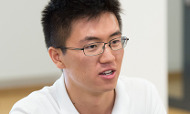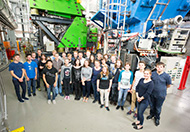 CAREER
CAREER
25. September 2018
Attractive Internship Program for Young Talent
A special internship program regularly succeeds in getting talented young people to come to the Johannes Gutenberg University Mainz’s PRISMA Cluster of Excellence – Precision Physics, Fundamental Interactions and Structure of Matter. Seven students were welcomed this summer. Zhiyuan Wang is one of them. He took the opportunity to work on his own project in nuclear physicist Prof. Dr. Dmitry Budker’s team.
Photo: Peter Pulkowski
 LEARNING AND EXPERIENCING
LEARNING AND EXPERIENCING
6. November 2017
Making the invisible visible
It is the first exhibition in the School of Seeing on the Gutenberg campus that is concerned with the natural sciences. Through its ZoomIn—Making the Invisible Visible show, the Precision Physics, Fundamental Interactions and Structure of Matter Cluster of Excellence, or PRISMA for short, is providing insight into its many and varied branches of research. Multimedia exhibits show how modern technology is used to gain an in-depth view of the world’s tool box.
 LEARNING
LEARNING
19. September 2016
Doing research like a real scientist
During this year's summer break, 24 high school students from all over Germany came to Mainz University to visit the MAMI Microtron, a particle accelerator that generates electron beams. At the invitation of the PRISMA Cluster of Excellence, they attended the first Mainz Particle Physics Academy here on the Gutenberg Campus. Professor Matthias Schott of the Institute of Physics at Johannes Gutenberg University Mainz (JGU) designed and organized the event bringing together top-flight research and teaching for two weeks.

PORTRAIT
9 JANUARY 2015
Not everything in the universe is symmetrical
Research into fundamental symmetries and a unique nationwide cooperation between Johannes Gutenberg University Mainz (JGU) and the Helmholtz Association have brought Professor Dmitry Budker to Mainz. He will be heading up the Matter Antimatter Symmetry section at the JGU-based Helmholtz Institute Mainz, which collaborates with the GSI Helmholtz Center for Heavy Ion Research in Darmstadt.

RESEARCH
25. NOVEMBER 2014
What holds matter together?
Subatomic particles, muons, quarks, gluons, and their cousins: Physicists working with the MAMI electron accelerator at Johannes Gutenberg University Mainz (JGU) are also playing an important role in the BESIII Experiment in Beijing in China. They are on the trail of the basic building blocks of matter and are thus hoping to pave the way for a New Physics.
 CAREER
CAREER
16 JUNE 2014
We need more women at the top
She is a high-ranking executive of a large concern: Marianne Heiß visited Johannes Gutenberg University Mainz (JGU) to talk about her career and what has to change so that more women are appointed to management posts. She was invited to speak as part of the new Irène Joliot-Curie Program that has been established in order to promote the careers of women working in the PRISMA Cluster of Excellence.

RESEARCH
14 February 2014
Hunting neutrinos in the Antarctic
Over the past three years, the IceCube neutrino observatory at the South Pole has managed to detect extreme high energy neutrinos originating from the depths of the universe. Even experts doubted for a long time whether the idea would work, but reports of success came in 2013. Professor Lutz Köpke of the Institute of Physics at Mainz University and his work group are involved in the international research project.

RESEARCH
27. December 2011
Higgs boson electrifies Mainz physicists
Matthias Neubert and his team are elated since scientists at Geneva's CERN research center found the first indications of the existence of the Higgs boson. This is the last building block missing from the standard model of physics. The head of the Theoretical Elementary Particle Physics unit at Johannes Gutenberg University Mainz (JGU) now expects his area of research to take off.

 CAREER
CAREER
 LEARNING AND EXPERIENCING
LEARNING AND EXPERIENCING
 CAREER
CAREER